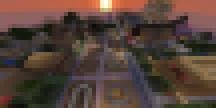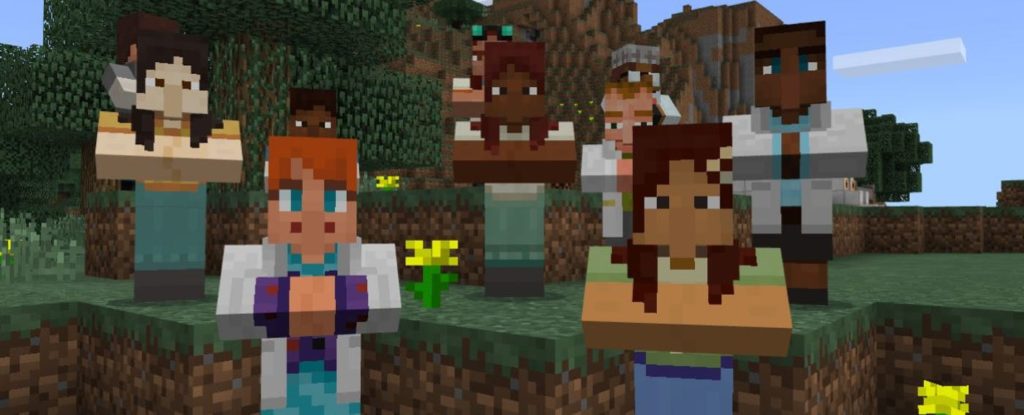My students come from a small, rural community and lack a broad understanding of the larger world around them. This inspired me to seek out a game, or online environment, that could provide more expansive experiences for them—a place that would allow them to explore, on their own or with others, and where I could embed history content for them to discover. On Twitter I came across an exploratory discussion of Minecraft’s potential for school use. I dove in and began a journey that ultimately changed my perception of teaching and how I interact with my students.
Minecraft is easy to use and implement in a classroom. It promotes student independence and creativity, but it is also an immensely collaborative tool that I have witnessed being integrated across all grade levels and content areas. Students can apply their understanding in truly unique and often unanticipated ways. Previously, my kids struggled with writing. Today, they are more creative and confident writers. Instead of getting 125 essays written in the exact same style with the same details, I now get unique historical narratives, rich with sensory experiences and observations made with their own eyes.
Minecraft: Education Edition—currently available for Windows 10, macOS and iPad devices—is nearly identical to the version students play on their own at home. The main difference is that the education edition comes with tools for teachers to make classroom implementation easier. If you are contemplating using Minecraft with your students, here are a handful of tips to help you get started.
Minecraft is easy to use and implement in a classroom. It promotes student independence and creativity, but it is also an immensely collaborative tool.
1. Engage kids in conversations.
Ask them what they like about Minecraft. Answers will likely revolve around the collective themes of creativity, collaboration, critical-thinking and communication. I began my journey with lunchtime conversations that helped me form implementation strategies and which ultimately led to the founding of a Minecraft club complete with membership cards. This videodoes a wonderful job of visually demonstrating the appeal of the game.
2. Explore YouTube video tutorials.
I really didn’t know anything about the game, so I did a keyword search for “Minecraft” and discovered over 140 million videos! Many of these have been created by students like ours honing their skills as content producers. Some helpful examples can be found here and here.
3. Identify your “experts” in the field.
Beginning gameplay with an experienced player or two—a student or even your own children—is a great way to learn the basics before attempting to teach with Minecraft. In class, I recommend selecting a few resident experts at the outset and asking them to mentor you and other students. This was a key revelation for me. I was not the expert, and I had to make my peace with that. It was a transformative experience. Students began to lead the lessons and roamed the room helping others. It empowered even my shy students to step forward into a mentor role.
If you prefer to do a bit of preliminary homework on your own, Stampy, the famous Minecraft YouTuber, created a very helpful video for first-time players.
I begin the school year with an open discussion about empathy and bullying. At the end of the session, students produce a “Minecraft Bill of Rights” poster that we hang in class as a reminder.
4. Explore a pre-loaded starter world available through the launcher.
Minecraft games are played in “worlds.” You will find any number of students interested in exploring along with you, so open a dialogue and uncover what kinds of worlds they value and what elements stand out. Simply boot up the game and select an available world—it will load automatically. You can also visit the online world library and download as many as you wish. Some of my personal favorites include Arctic Shipwreck, Project Storytelling, and Fantastic Mr. Fox.
Don’t feel that you must structure this time around learning objectives. The most useful feedback, along with other benefits, will come from unstructured play and exploration.
5. Don’t succumb to the pressure to create your own lesson at this stage.
There are plenty to investigate here. But before selecting one to try out in your classroom, you need to have a clear objective in mind. Consider joining the online community of Minecraft educators. Doing so will give you access to lesson authors and to the wider group of mentors who are happy answer your questions.
6. Try a short-term lesson with students.
Good lessons are student-centered and require little setup by the teacher, but you should still preview the lesson and “walk” through it as a student. Lessons can be easily differentiated for students and objectives modified to fit individual needs. The Building a Story Setting lesson provides an excellent introduction.
7. Discuss griefing behaviors and how to build positive relationships with Minecraft.
Griefing occurs when one or more students intentionally destroy or steal the work of another. I begin the school year with an open discussion about empathy and bullying. At the end of the session, students produce a “Minecraft Bill of Rights” poster that we hang in class as a reminder.
8. Create your own lesson.
Keep it simple with clear objectives that can be completed over one or two sessions. Students transport themselves into the game and quickly settle in. I discovered that I needed to frontload what I wanted them to achieve each session and monitor progress consistently. Take a look at how Minecraft Mentor Stephen Elford prepared students for success with his Contour Maplesson.
The ability to reach students across content and grade levels is astonishing.
It’s easy to get off task, so objectives should be attainable and positive outcomes rewarded with feedback. I prefer assessments that promote critical thinking and written reflection over build quality. My first large-scale lesson tasked students with building a Chinese city and populating it with citizens. Based on individual experience level, students assigned themselves to city blocks I had prepared and built out the city. Once completed, they wrote detailed historical narratives about the citizens that lived in “their” buildings.

9. Form a “build team” partnership with students.
You do not need to become an expert in Minecraft, nor do you need to possess advanced building skills. I formed a build team of students that got together at lunch, and they helped me build worlds for future lessons. [Photo] Each student has specialities, and together we have built some amazing worlds. One of my favorites is the Round City of Baghdad.
10. Avoid thinking of this as just building objects.
The ability to reach students across content and grade levels is astonishing. Consider what other educators have accomplished with Minecraft in the classroom.
Minecraft Mentors Simon Baddeley and Ben Spieldenner have partnered up to create a series of literature-rich projects that allow students to explore and interact with characters to experience language functions and themes.
Stephen Reid tackles the difficult subject of the refugee crisis in this unit devoted to exploring social and emotional learning, which allows students to experience the world from the perspective of a child refugee.
Benjamin Kelly has created a wonderful lesson focused on empathy education. A series of wildlife conservation challenges have been created for Minecraft: Education Edition users that explore concepts such as poaching and land-use conflicts.
More Resources for Getting Started
- If you are ready to learn about the capabilities of Education Edition, Microsoft has created a helpful introductory course.
- Need help with Minecraft related vocabulary? Visit Common Sense Media to familiarize yourself.
- Ready to dive deeper? The ultimate resource is the Official Minecraft Wiki.
- Looking for help understanding the keyboard controls? This article is an excellent resource.
- Read more tips for classroom management and creating a positive classroom culture.
- These case studies highlight how other educators are using Minecraft to drive learning.
- Just try it. Here’s a free trial of Minecraft: Education Edition.
John Miller, a veteran educator from King City, CA, is currently in Singapore with the Fulbright Distinguished Awards in Teaching Program.
This article is part of a guide to game-based learning, sponsored by Minecraft: Education Edition. The sponsor has no control over the content of this story. To learn more, please read our Ethics Statement.
